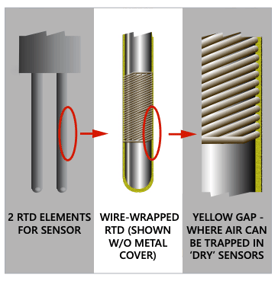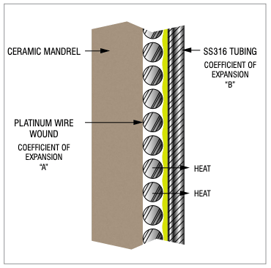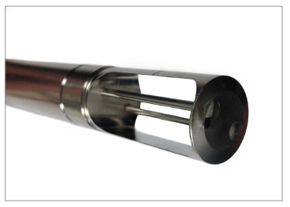The accuracy of a thermal mass flow meter is dependent upon the technology type and the quality of the materials used for the meter’s sensor design. A well-designed sensor is made to measure flow accurately over a long period of time with minimal drift, independent of recalibration and calibration validation diagnostics. For a thermal mass flow meter, the materials used in the manufacture of the sensor play a vital role in the overall performance of the sensor. The materials must create the best environment for heat transfer - the essential principle of thermal mass flow measurement - or the accuracy and response time suffer.
‘WET’ VS ‘DRY’ SENSORS
 When discussing the type of sensors used in thermal mass flow measurement, manufacturers will often label them ‘wet’ or ‘dry’ sensors. A ‘wet’ sensor, unlike a ‘dry’ sensor, contains a Pliable Heat Transfer (PHT) Compound/Coating material that eliminates potential air gaps between the wires and the protective metal sleeve. Air gaps interfere with heat transfer in the sensor thus reducing accuracy.
When discussing the type of sensors used in thermal mass flow measurement, manufacturers will often label them ‘wet’ or ‘dry’ sensors. A ‘wet’ sensor, unlike a ‘dry’ sensor, contains a Pliable Heat Transfer (PHT) Compound/Coating material that eliminates potential air gaps between the wires and the protective metal sleeve. Air gaps interfere with heat transfer in the sensor thus reducing accuracy.
The filler material is pliable and non-hardening in order to act as a sealant, a shock-absorber, and to aid in optimal heat transferability. In the diagram Figure 1, two RTDs from a typical sensor are shown. In the center, one RTD element is enlarged; it is shown without the protective metal surface that encapsulates the element to expose the wire wrapped around the mandrel. On the right, the yellow space illustrates the air gaps that can be formed between the wire and the metal encasement in ‘dry’ sensors.
 A ‘dry’ sensor can have the ceramic mandrel, the platinum wire, a brittle glass coating, and the stainless steel cover in direct contact resulting in air gaps and creating a coefficient of thermal expansion that leads to - among other problems - compromised accuracy and slower response time.
A ‘dry’ sensor can have the ceramic mandrel, the platinum wire, a brittle glass coating, and the stainless steel cover in direct contact resulting in air gaps and creating a coefficient of thermal expansion that leads to - among other problems - compromised accuracy and slower response time.
Crimping the steel cover to the wire-wound mandrel has been one way to reduce the expansion area, but this does not sufficiently reduce the potential for expansion. Therefore, a ‘dry’ sensor is more susceptible to expansion and contraction within the RTD. Lack of a filler material can also result in an improper seal, leaving the sensor vulnerable to moisture, which could cause further expansion and contraction within the RTD. Over time, this may result in damage to the elements through cracks, breakage, or corrosion. Thermal expansion and contraction cycles with a ‘dry’ sensor results in changing thermal conductivity, compromised accuracy, and long term instability. Ceramics and metal have a significantly different coefficient of thermal expansion. Even if they start in contact with each other due to precompression, the contact area will be reduced as the sensor heats up and the metal sheath expands away until it is no longer in contact. The changing contact with each temperature cycle is eliminated in a ‘wet’ design.
A BETTER SENSOR DESIGN - ‘WET’ WORKS
Fox Thermal mass flow meters use a ‘wet’ sensor type. Each RTD is made up of a ceramic mandrel with reference grade platinum wire wound around the mandrel. The wire-wrapped mandrel is then coated in a Pliable Heat Transfer (PHT) Compound/Coating and encased by a stainless steel tube. The coating fills the space between the wire and the tube and creates a better, more even seal between the mandrels and the metal surface. Fox uses the ‘wet’ sensor because it also allows for better heat transfer, minimal drift, higher accuracy, faster response time, and protection from the effects of moisture.
METER CALIBRATION LONGEVITY
Every flow technology experiences drift over time. Thermal mass flow measurement technology is proven to be highly accurate, easy to install, and have lower maintenance costs due to its no moving- parts design. A meter is only as good as its calibration. Experience shows that ‘dry’ sensors will produce more drift over time.
CALIBRATION VALIDATION PROVES DESIGN SUPERIORITY
Calibration Validation is a built-in feature designed to: • Test the functionality of the sensor and its associated signal processing circuitry • Check for build-up on sensor that could affect calibration • Ensure that the meter still retains its original NIST-traceable calibration • Check thermal conductivity (heat transfer) repeatability of the sensor Use Calibration Validation to assure the meter is functioning correctly and to produce records for regulatory compliance when needed.
FOX THERMAL’S DDC-SENSOR™ TECHNOLOGY
 The Fox Thermal DDC-Sensor™ is the state-of-the-art sensor technology used in the latest Fox Thermal Models FT1, FT4A, and FT4X. The DDC-Sensor™, a Direct Digitally Controlled sensor, is unlike other thermal flow sensors available on the market. Instead of using traditional analog circuitry, the DDC-Sensor™ is interfaced directly to the flow meter’s microprocessor for more speed and programmability. The DDC-Sensor™ accurately responds to changes in process variables (gas flow rate, pressure, and temperature) to determine mass flow rate, totalized flow, and temperature.
The Fox Thermal DDC-Sensor™ is the state-of-the-art sensor technology used in the latest Fox Thermal Models FT1, FT4A, and FT4X. The DDC-Sensor™, a Direct Digitally Controlled sensor, is unlike other thermal flow sensors available on the market. Instead of using traditional analog circuitry, the DDC-Sensor™ is interfaced directly to the flow meter’s microprocessor for more speed and programmability. The DDC-Sensor™ accurately responds to changes in process variables (gas flow rate, pressure, and temperature) to determine mass flow rate, totalized flow, and temperature.
Fox Thermal’s DDC-Sensor™ provides a technology platform for calculating accurate gas correlations. The correlation algorithms allow the meter to be calibrated on a single gas in the factory while providing the user the ability to select other gases or gas mixes in the Gas-SelectX®®menu. Fox Thermal’s DDC-Sensor™ and advanced correlation algorithm make up the most advanced thermal gas flow meter technology on the market today.
